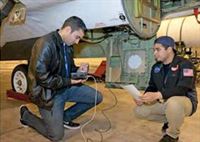Фотографии
-
Most payloads are carried in four pressurised compartments in the central fuselage equipment bay, but they are also installed in the wing and cockpit.
Самолёты на фотографии: Lockheed U-2R - США - 1967
-
Регистрационный номер: N809A One of two ER-2s operated by NASA as part of the Airborne Science Program.
Самолёты на фотографии: Lockheed U-2R - США - 1967
-
A second ER-2 pilot driving a Dodge Charger chase car plays a crucial role by calling out the aircraft;s descent rate and proximity to the ground to the flying pilot over the radio.
Самолёты на фотографии: Lockheed U-2R - США - 1967
-
Самолёты на фотографии: Lockheed U-2R - США - 1967
-
The taildragger configuration and large wingspan means the ER-2 is challenging to fly. After lift-off, the pilot holds the aircraft level for a couple of seconds before pulling into a 45° climb.
Самолёты на фотографии: Lockheed U-2R - США - 1967
-
Before each mission an ER-2 pilot spends an hour in life support getting suited up and pre-breathing 100% pure oxygen. Life support personnel assist the pilot to the aircraft; there are about 13 connections the technicians will use to strap them in.
Самолёты на фотографии: Lockheed U-2R - США - 1967
-
The ER-2 is a modular aircraft, with payloads installed and removed from the fuselage bay and wing pods as research requirements change over time.
Самолёты на фотографии: Lockheed U-2R - США - 1967
-
Регистрационный номер: N806A The ER-2s are responsible for testing prototypes of sensors which will go into space; here ER-2 N809NA prepares to fly the Multiple Altimeter Beam Experimental Lidar on a test flight.
Самолёты на фотографии: Lockheed U-2R - США - 1967
-
A wide variety of science instruments have been carried by the ER-2s. Here technicians download collected data; the aircraft also have instrumentation and video transmission capabilities.
Самолёты на фотографии: Lockheed U-2R - США - 1967
-
Pitot Tom Ryan during a mission. The bulky spacesuit and helmet restrict the ER-2 pilot's movement.
Самолёты на фотографии: Lockheed U-2R - США - 1967
Статьи
- -
- Airscene
- Backpages
- News by countries
- ??? - UK Air Power /Military/ (2)
- A.Mladenov - Still going strong /Commercial/
- A.Mladenov, K.Grozev - An-225 Mriya. Heavy lift dream machine /Commercial/
- B.Taghvaee - New claws for the Persian Cats /Military/
- L.Mennes, F.Visser - Going tactical /Military/
- M.Ayton - American Buzzards in the UK /Military/
- M.Ayton - Smart teaming /Technology/
- M.Broadbent - BelugaXL /Commercial/
- M.Broadbent - High flight /Technology/
- R.Yanez, A.Rodriguez - Draken's Supersonic aggressors /Military/









